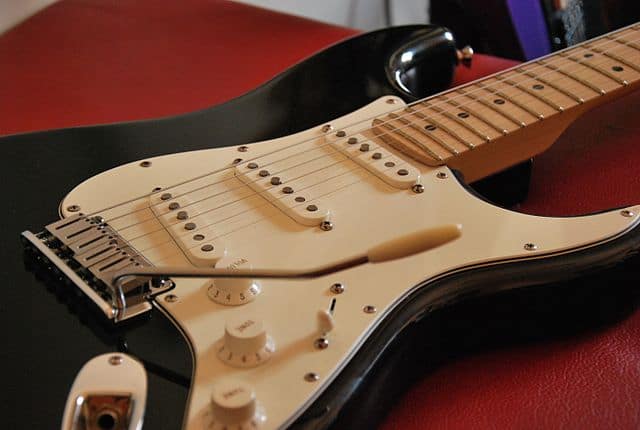Strats are maybe part of the most iconic guitars of all time.
Since there are as many Stratocasters as musicians, each guitar player can choose the desired model.
We can find loads of options among them, including standard config, different neck shapes, and radii, or even electronic specs.
Today we will compare hardtail and blocked trem Strats, many players believe that they are identical but, are they exactly the same?
In fact, hardtail and blocked trem Strats are different assemblies for the same guitar model. The latter is known for presenting a tremolo arm capable of altering the pitch whereas the former provides a fixed bridge.
Although you can picture the idea, this topic has many points to discuss.
Through this article, we will try to cover each of them to give you a wider perspective of these two Strat designs.
What does Hardtail mean for Strats?
A Hardtail Stratocaster is a Strat model which presents a fixed bridge in its design.
Strats usually have a floating tremolo system hence the difference is noticeable.
Although floating tremolo Strats are mainly thought of as the standard for this guitar model, many players go for hardtail pieces due to the advantages they offer.
One major benefit is the superior tuning stability and intonation.
Thanks to the fixed bridge, hardtail Strats have fewer moving parts than their floating counterpart, resulting in a more stable tone.
Besides, this sort of bridge also offers improved sustain because fewer mechanical parts damp the vibration and resonance of the strings.
However, this assembly lacks musical flexibility provided by tremolo systems.
Since hardtail pieces do not have any movement, they cannot alter the pitch up or down when playing the guitar.
These amazing models provide wonderful characteristics desired for loads of guitarists but hardtail Strats is a broad topic to fully cover.
Fortunately, Gear Aficionado is here to help you, if you want to know more about Hardtail Stratocasters, here you have an article that deeply explains every concerning aspect.
What is a blocked tremolo?
In contrast to fixed bridge Strats, we can find floating tremolo systems.
This design is traditional for Fender Stratocasters and offers the possibility of achieving groundbreaking sounds by pulling or pushing the whammy arm.
Nevertheless, this assembly presents intonation issues and inconveniences to keep tuning. That’s why Strat players tend to block the vibrato to boost their playing.
But you may wonder, what is a blocked tremolo? Well, it refers to a mod in which you limit the range of movement of the bridge.
By doing this, your guitar improves in intonation and sustain without losing the ability to alter the pitch.
When blocking the vibrato you don’t eliminate movement, you reduce it and that’s why you can still do dive bombs while playing.
However, as you keep the pushing but not pulling option, you can still go down in pitch but not up anymore.
Are Hardtail and blocked tremolo Strats the same?
Contrary to what most people believe, hardtail and blocked tremolo are not identical.
The main incompatibility is the kind of bridge they have in their construction.
In addition, if you compare both you will find that tuning and intonation are different.
The same occurs regarding playability and, as mentioned earlier, the sustain varies as well.
To sum up, the two pieces are designed differently, resulting in unalike performances in each case.
Although they seem similar, they offer contrasting outcomes.
Will a blocked tremolo Strat work just like a Hardtail one?
When blocking a tremolo we are partially imitating the performance of a hardtail one.
By doing that, we intend to reinforce problematic issues such as intonation and sustain while keeping the tremolo function.
However, a hardtail and a blocked tailpiece won’t work equally.
Hardtail bridges are completely fixed systems, with no movement in any direction.
Oppositely, blocked vibrato systems present a whammy bar used for lowering the pitch of the strings.
Therefore, although a blocked tremolo tries to emulate some characteristics of a hardtail piece, it doesn’t do it faithfully and it presents its own features.
We cannot assume that both systems are identical.
The two designs have as many similarities as differences plus both offer different flavors.
Think of blocked tremolo Strats as just a step in between a regular strat and a hardtail.
Are there any drawbacks to blocking a Strat tremolo?
Like with everything in life, we may face pros and cons of this mod.
The most noticeable disadvantage is that a blocked tremolo is not as stable as a hardtail.
By blocking it, you will perceive an improvement in stability but nothing is as stable as an originally designed fixed bridge.
Apart from that, there are no major disadvantages.
Well, of course, you wouldn’t be able to use the whammy bar effectively, but that’s the whole point of it.
Up to this point, everything relies on the player’s preferences, what could be a downside may be great for others.
Therefore, we can conclude that blocking a Strat tremolo will bring you more benefits than drawbacks.
How to block the tremolo of a Strat?
Now we have said that by blocking your vibrato tailpiece you will have many advantages you may be considering on doing it.
Despite seeming a tough task, is not as hard as thought and if you have a knack for crafting it will be quite straightforward.
There are two common ways to do this job, one of them involves using wooden pieces whereas the other relies on the springs’ tension.
For the first procedure, you will need shims of wood or any piece of hardwood.
The goal is to set the pieces of wood in the lower and upper cavities between the body and the tremolo system. In that way, you will fix the vibrato, limiting the movements of the whammy arm.
To do this process, you will need hand tools commonly found in everyone’s home.
A screwdriver, some glue, a measuring device, and any tool that works to cut the block of wood.
The second option consists of avoiding the use of wood. What you have to do is tighten the spring claw screws and place the claw plate flush against the body.
As you are not dealing with wood you won’t need any glue to do this task.
However, you do need the five springs (Strats usually come with just three of them) because you require more exerted tension.
Although both options are reliable, sticking to the first one will bring you less trouble due to you don’t need any additional components apart from blocks of wood.
Nonetheless, try the one you like the most, and if you have the required amount of springs you can even combine both.
Since it could be a difficult job for some musicians, it is always recommended to take your guitar to a tech when doing modifications.
Fortunately, in Gear Aficionado we have profoundly covered this amazing issue so you can check our article “How to Block a Strat Tremolo? [Complete Guide]” for further information.

Hello there, my name is Ramiro and I’ve been playing guitar for almost 20 years. I’m obsessed with everything gear-related and I thought it might be worth sharing it. From guitars, pedals, amps, and synths to studio gear and production tips, I hope you find what I post here useful, and I’ll try my best to keep it entertaining also.





